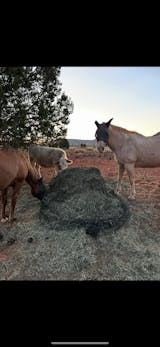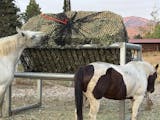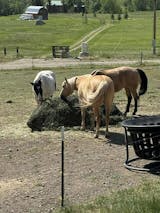8x3x3, 8x4x3 & 8x4x4 Knotted Large Square Bale Slow Feed Hay Net
Frequently Bought Together
Description
Our GutzBusta® Square Bales 8x4x3 nets will fit both sizes of large square bales (8x3x3, 8x4x3 & 8x4x4). The new design makes them larger and easier to put on. It reduces the incidence of colic, choke, stomach ulcers, boredom, hay wastage, and vices.
This size hay net is basically a 'one size fits all' hay net as it will fit these Large Square Bales, as well as all sizes of round bales up to 6x5. This is how easy it is to adjust the hay net down a size.
Large Square Bales - one hay net fits both sizes:

-
Hay Bale Dimensions:
- 8x3x3" (2.4m x 0.9m x 0.9m)
- 8x4x3" (2.4m x 0.9m x 1.2m)
- 8x4x4" (2.4m x 1.2m x 1.2m)
- Net Colour: Black
Click here for a YouTube video on how to put a GutzBusta hay net on a Large Square Export Bale 8x3x4, 8x4x3 & 8x4x4.
What material are the Gutzbusta® Hay Nets made from?
Our GutzBusta® Slow Feed Hay Nets are made from tough and durable, UV Stabilized, and heat-treated netting in 60ply polyethylene netting. This netting will not absorb water, therefore there is no change to the properties of the netting during inclement weather or if used to soak hay.
What hole size will suit my horse or livestock?
Available in 1 1/4" (3cm), 1 3/4" (4cm), 2 1/2" (6cm) 60ply, our Slow Feed Hay Nets are made from tough, durable, UV Stabilized, and heat-treated 60ply polyethylene netting. This netting is not water-absorbent, so you don’t have to worry about your net getting heavy when soaked in water.
There are many things that dictate which sized hole will suit your individual situation, some of which are discussed here.
How to use GutzBusta® Large Square Bales?
We have a detailed Blog on this topic here.
Why use GutzBusta® Slow Feed Hay Nets?
Studies have shown that using slow-feed hay nets such as our GutzBusta® Hay Net Feeders also decreases wastage by up to 46%. We’ve been making hay nets for over 8 years and we know how the netting behaves over time. This is why we developed a size and pattern that works to enable these nets to last longer.
Our GutzBusta® Large Square Bales are easy to put on and come with a large drawstring to easily secure the hay net around your square bale.
Our products are the most generously sized and designed to be easier to put on compared to other hay nets available in the market.
For more information and photos about our hay nets, please visit our livestock page and our FAQ & Help page.
How to use GutzBusta® Large Square Bales?
Simply place your large square bale on its side so you can cut and remove the strings easily, then open up and lay the hay net along the top of the bale. Pull the net down towards the ground until it totally surrounds the bale, then take up the slack with the drawstring and secure the net around the bale. If you have a tractor or ute then you can gently tip the bale up slightly from one long side and then the other to be able to put the netting underneath the bale. Although this net will not totally encapsulate an 8x3x4 bale, it will come close and these bales are too heavy to be pushed over by a horse anyway.
Our blog page gives an extensive pictorial and video on how to put the hay nets on these bales.
These bales can weigh from 1100lb to 1500lb (500kg to 700kg), we do suggest that you leave one string in place on your bale (bottom or second bottom string) to give the bale and net support until some of the bulk of the hay has been taken out. Once some of the bulk is eaten from the bale, then we recommend cutting and removing this final string.
When you tie up and secure the drawstring, make sure the excess rope is either tied back up into the net itself or that you tie a knot in the drawstring at the base of the net. Then, undo the simple knot at the end of the drawstring. You can leave the remaining drawstring loose or once you have pulled up and tied it off into the net, or you can put the remaining drawstring under the bale (if you have a tractor or are able to lift or tip the bale). Although this is related to round bale, you may wish to watch this video for more ideas on how to deal with your drawstring.
Please note that our hay nets are on the generous side, so they will allow for individual size variances depending on the farmer who makes the bales.
Caution:
- Shoes: If your horse is shod then simply tie your net up a little higher if it is a smaller net. If you are using a round bale or larger size net, then put your net inside a large box, hay ring or other device that stops their feet from coming into contact with their hay net. Direct contact of shoes and nets is not recommended.
- It is not recommended to leave buckled halters or other types of buckled headgear on your horse when using ANY type of hay net as your horse may get caught.
- Similarly, do not let horned animals such as cattle, sheep or goats eat from the nets due to possible entanglement.
- Cattle or stock with ear tags are cautioned from eating from the hay nets as they may rub their head and potentially remove the ear tags.
- It's important to keep in mind that horses wearing rugs might rub against the nets. To reduce the chance of a rug clip getting caught on the netting, make sure your buckles are properly secured and not sticking out, or consider securing the hay net to limit contact between the rug and the net. If rubbing is a concern, you might want to avoid having your horse wear a rug altogether.
FAQs
Which Hole Size should I choose?
When choosing a hay net hole size, several factors should be considered. Here is a short summary of the key points for each hole size:

¾” Extreme Slow Feed Sized Holes:
- Suitable for "expert level" ponies that can eat from 1 ¼” hay nets at impressive speeds.
- Recommended for horses or ponies that have mastered eating from a 1 ¼” hay net.
- Ideal for feeding Lucerne, soft, fine, very palatable pasture hay to greedy horses or ponies.
1" Slow Feed Sized Holes:
- Experienced ponies, miniatures & extreme gobblers
- Ideal for feeding Lucerne, soft, fine, very palatable pasture hay to greedy horses or ponies.
1 ¼”Decelerator Sized Holes:
- Great for voracious eaters, such as ponies, minis, and horses familiar with slow feed hay nets.
- Laminitic horses usually benefit from 1 ¼” sized hay nets.
- Relieves boredom for stabled horses or as a backup net for when the first hay net empties.
- Recommended for gutzy horses, ponies, or livestock, especially with palatable hay or slow feed experience.
- Not commonly used for goats, cows, or sheep, but some may use it with palatable hay.
1 ¾” Moderate Sized Holes:
- The most popular hole size for slow feeding, accepted by over 90% of horses.
- Suitable for slightly stalky hay, providing hay-saving benefits and increasing hay longevity.
2 ½” Free & Easy Sized Holes:
- Ideal for saving on hay without significant restriction.
- Commonly used with low-sugar or coarse and stalky hay, great for older horses and cattle.
- Suitable for pregnant broodmares or younger horses where slow feeding is unnecessary.
- Caution: Ensure hoof size is larger than netting size for horse safety.
General Considerations:
- GutzBusta 1 ¾” holes are a good starting point, with flexibility to go up or down in size.
- Weather and hay type can influence the suitable hole size.
- Palatability determines the hole size, with more palatable hay allowing for smaller holes.
- Horse's health status, weight, and workload should be considered when choosing a hole size.
- 1 ¾” and 2 ½” sizes are suitable for saving on wastage, while 1 ¼” slows down eating.
- Monitor horse's response when introducing a new hay net to avoid over-facing.
- Different livestock can use various hole sizes, with 1 ¾” being common.
- Different hole sizes are used throughout the year, for various hays, health conditions, and weight management.
- Be cautious with shod horses and use appropriate hay rings/feeder to prevent entanglement.
- If you intend to soak hay in your net, we recommend rinsing the net in cold water prior to first use for a few minutes.
Which Bag Size should I choose?
| Hay Net Size |
Knotless (Width x Height) |
Knotted | Approx Capacity |
| Extra Small |
55cm x 65cm 21" x 25" |
65cm x 55cm 25" x 21" |
|
| Small |
70cm x 80xm 27" x 31" |
70cm x 80cm 27" x 31" |
|
| Medium |
95cm x 85cm 38" x 34" |
89cm x 79cm 35" x 31" |
|
| Large |
140cm x 100cm 55" x 39" |
140cm x 100cm 55" x 39" |
|
| Extra Large |
160cm x 150cm 63" x 59" |
160cm x 150cn 63" x 59" |
|
| Hay-Stay Hanging Hay Net |
160cm x 100cm 62" x 39" |
|
|
Note: Weight can vary depending on the type of hay, whether you’re filling from a round bale or using biscuits/flakes, and how tightly the net is packed. Larger nets may also hold different weights based on the hay used. Our hay nets can handle a significant load, so the listed capacities are a general guide, they’re capable of holding more if required.
Knotless vs Knotted
Our Knotted and knotless hay nets are made from UV-stabilized polyethylene netting and have been in use for 8 years. They come in various ply sizes and are tough, durable, and easily repairable. They have been used by many horses and can last 2 to 6 years. Knotted nets are suitable for soaking hay and do not take on the weight of water. They are available in black and offer hole sizes of 30mm, 40mm, and 60mm.
On the other hand, the knotless hay nets are made from high-strength, UV Stabilized polypropylene and have been available since 2019. They are softer and do take on some weight when soaked. The deluxe knotless nets are considered more luxurious and have become popular due to their softness. They are the strongest on the market with 240 ply and come in hole sizes of 20mm, 30mm, 40mm, and 60mm. Knotless nets are also only available in black.
When it comes to strength and longevity, there isn't a significant difference between knotted and knotless nets. Both types have proven to be tough, durable, and long-lasting. While some horses may prefer one material over the other, there is no way to predict which will suit an individual horse better without trying them. Ultimately, the lifespan of the nets depends on the individual horse and usage. Knotted nets have been used for 2 to 6 years without needing repairs, while the lifespan of knotless nets is still unknown after 3 years of use.
Returns & Exchanges
We want you to be completely satisfied with your purchase from our store. If you have any issues with your order, please contact us at Gutzbusta so that we can make it right. We have a clear and concise Returns and Refund Policy to make the process as smooth as possible.
CLICK HERE TO DOWNLOAD RETURN REQUEST FORM
Returning Items
To return an item, please contact us at our customer service team via the email below. Make sure to include your order number when contacting staff.
Please pack the item securely in its original packaging and include all accessories and documentation, making sure the order number is clearly visible on the box. We will not accept items that have been modified or used in any way.
PLEASE BE AWARE: You are responsible for the cost of return shipping, unless the item is damaged or faulty.
Email: sales@gutzbusta.com
Our Postal Address:
Gutzbusta
2020 Industrial Blvd
Rockwall
TX 75087
Change of Mind
We accept returns for change of mind within 30 days of purchase. These can included swapping or exchanging item(s) for different sizes. The item(s) must be unused, in their original packaging, and in the same condition as when you received them.
We will issue a refund for the purchase price of the item(s) once we receive the item(s), excluding any shipping costs. While this process is under way, it is better to re-order with the correct item(s) to ensure your exchanged item(s) are delivered to you in a timely manner.
Incorrect Items Received
If you received the incorrect item(s), please contact us immediately. We will cover the cost of shipping the incorrect item(s) back to us. We will issue a replacement as soon as possible to you at no extra cost.
Damaged or Faulty Returns
If you receive damaged or faulty item(s), please contact us immediately. We will require photographic evidence of the damage or fault before we can process a return. We will cover the cost of shipping the item(s) back to us, and we will issue a replacement or full refund as soon as possible.
Damaged in Use
If your horse is using our nets and the net becomes damaged during use, please contact us immediately. We will require photographic evidence of the damage as well as the order number. Depending on the situation, we may offer a repair kit or exchange, subject to our discretion. Please note that general wear and tear, or damage caused by misuse may not be covered under our returns and refund policy.
Refunds
Once we receive your returned item(s), we will inspect it to ensure that they are in resalable condition. If the item(s) are in resalable condition, we will issue a refund to the original payment method within 7 business days. Please note that it may take up to 10 business days for the refund to appear on your account, depending on your bank or credit card company.
Thank you for shopping with us. If you have any questions or concerns about our Returns and Refund Policy, please do not hesitate to contact us.














